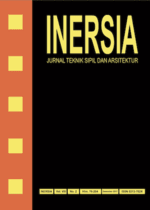PENGARUH GENANGAN AIR TERHADAP PENGECORAN BETON IN-SITU
DOI:
https://doi.org/10.21831/inersia.v14i2.22538Keywords:
beton, foot plate, genangan, campuranAbstract
ABSTRACT
High rainfall intensity maybe occur during the dry season. This can certainly disturb the erection of a building project, especially in a case of construction works requiring dry condition, such in concrete item. Various attempts have been made to reduce the height of the puddle, when mixing the fresh concrete in a frame work of sub-structure elements, e.g. the foot-plate foundation. The puddles in the foundry area potentially affect the composition of the mortar especially in water-cement ratio (wcr). This caused a decrease of compressive strength (f'c) of the concrete then causing the quality decreaseof the concrete. This research used two types of mixed concreteconditions: dry and waterlogged condition. The water cement ratioshould be changed when mixing concrete had been performed in waterlogged condition. One determinedcontrol sample was based on a normal concrete mixture with characteristic strength (f'c) = 25 MPa. The standard of concrete mixing used is SNI-2834-2000 on the mixingprocedure of a normal concrete mixed design. The concrete sampleswere tested using a concrete compressor universal test machine (UTM) than comparedto hammer and Ultra Pulse Velocity (UPV) test.Based on the results of the study, the quality of mixed concrete in waterlogged conditions was much lower than the compressive strength design. The percentage reduction in compressed strength of mixed concrete under water submerged conditions ranged from 30.82% to 32.63% to normal concrete compressive strength. The higher level of puddlecaused the lower compressive strength of the concrete.There was a match between the measurements of concrete compressive strength using UTM comparedto hammer and UPV tests.The percentage differences in measurement of hammer test to UTM test results were 10.73% and 9.26% to 21.79% by the UPV test. Keywords: concrete, foot plate, mix design, puddle, wcrIntesitas hujan yang cukup tinggi juga dapat terjadi pada musim kemarau. Hal ini tentu dapat mengganggu pelaksanaan suatu pekerjaan bangunan, khususnya pekerjaan konstruksi yang telah disyaratkan untuk dikerjakan dalam kondisi kering. Berbagai macam upaya telah dilakukan untuk mengurangi tinggi genangan air pada saat pengecoran elemen sub-structure, seperti halnya pondasi telapak (foot-plate). Genangan air yang terdapat pada daerah pengecoran berpotensi mempengaruhi komposisi adukan khususnya pada faktor air semen (fas). Hal tersebut dapat mengakibatkan kuat tekan beton (f'c) berkurang sehingga mengakibatkan mutu beton menjadi berkurang. Kajian ini menggunakan dua jenis kondisi pengecoran, yaitu: kondisi kering dan kondisi pada genangan air. Faktor air semen berubah seiring dengan kegiatan pengecoran beton dalam kondisi basah (tergenang air). Satu buah sampel kontrol telah ditentukan berdasarkan adukan beton normal dengan kekuatan karakteristik (f'c) = 25 MPa. Standar pencampuran beton yang digunakan adalah SNI-2834-2000 tentang tata cara pembuatan rencana campuran beton normal. Sampel beton akan diuji dengan alat kuat tekan beton yang dilengkapi dengan dial ekstensometer sehingga dapat diperoleh kurva tegangan-regangan beton berdasarkan variasi fas yang diberikan. Berdasarkan hasil penelitianmaka kualitas beton yang dicor dalam kondisi tergenang air jauh lebih rendah dari nilai kuat tekan beton desain, Persentase penurunan kuat tekan beton yang dicor dalam kondisi terendam air berkisar antara 30,82% sampai dengan 32,63% terhadap kuat tekan beton normal, Semakin tinggi genangan air maka semakin rendah kuat tekan beton, Terdapat kesesuaian antara pengukuran kuat tekan beton menggunakan UTM dengan uji hammer dan UPV, Persentase perbedaan pengukuran uji hammer terhadap hasil uji UTM adalah 10,73% dan 9,26% sampai dengan Kualitas beton yang dicor dalam kondisi tergenang air jauh lebih rendah dari nilai kuat tekan beton desain, Persentase penurunan kuat tekan beton yang dicor dalam kondisi terendam air berkisar antara 30,82% sampai dengan 32,63% terhadap kuat tekan beton normal, Semakin tinggi genangan air maka semakin rendah kuat tekan beton, Terdapat kesesuaian antara pengukuran kuat tekan beton menggunakan UTM dengan uji hammer dan UPV, Persentase perbedaan pengukuran uji hammer terhadap hasil uji UTM adalah 10,73% dan 9,26% sampai dengan21,79% untuk uji UPV.Kata kunci: beton, foot plate, genangan, campuran
Downloads
Published
2018-12-21
How to Cite
Aminullah, A. (2018). PENGARUH GENANGAN AIR TERHADAP PENGECORAN BETON IN-SITU. INERSIA Lnformasi Dan Ekspose Hasil Riset Teknik Sipil Dan Arsitektur, 14(2), 158–168. https://doi.org/10.21831/inersia.v14i2.22538
Issue
Section
Articles
License
Authors who publish with INERSIA journal agree to the following terms:
- Authors retain copyright and grant the INERSIA journal right of first publication with the work simultaneously licensed under Creative Commons Attribution License (CC BY 4.0) that allows others to share the work with an acknowledgment of the work's authorship and initial publication in this journal.
- Authors can enter into separate, additional contractual arrangements for the non-exclusive distribution of the published version of the work (e.g., post it to an institutional repository or edit it in a book), with an acknowledgment of its initial publication in this journal.
- Authors are permitted and encouraged to post their work online (e.g., in institutional repositories or on their website) before and during the submission process, as it can lead to productive exchanges, as well as earlier and greater citation of published work.

INERSIA by https://journal.uny.ac.id/index.php/inersia was distributed under a Creative Commons Attribution 4.0 International License










